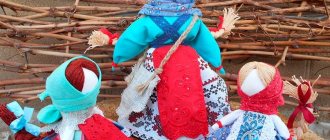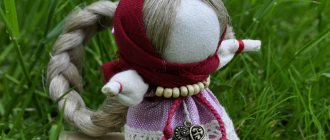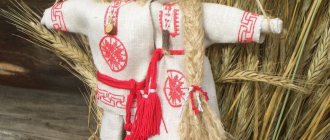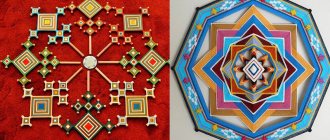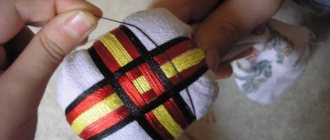- January 19, 2019
- Crafts
- Iuliia Batruddinova
The world of crafts is changing as quickly and unpredictably as the rest of the world. Just yesterday, detailed small embroideries were in fashion, but today the trend is simple, but such amazing primitives. Only yesterday everyone was completely addicted to diamond mosaics, but today everyone is sewing strange dolls without a mouth and without a nose.
Doll culture
In all cultures and countries, people have used dolls. Somewhere they were sewn, somewhere they were made from straw, and somewhere from porcelain. Some were dressed up in expensive elegant dresses and placed on shelves, others were used for rituals, others were carried with them or placed in a crib. In some countries, toys were monstrously realistic; in others, they made symbolic dolls without mouth and nose that only vaguely resembled a person.
Puppet culture, which has come to us from time immemorial, is growing and developing. Over the past decades, an incredible number of new toys have been created: a clumsy baby doll suddenly turned into a long-legged Barbie, then into a terrifying Monster High, and also acquired a male gender in the form of Ken. And then suddenly, unexpectedly, everything returned to its origins - a rag doll.
Types of Voodoo dolls
It is difficult to count all types of dolls, because there are many of them, as well as craftsmen. All of them are made from a variety of materials, they are given a certain appearance and different purposes. But there are a few rules that should be followed. Today, dolls are created to be used for popular purposes.
This:
- attracting success and good luck;
- love affection;
- removal of conspiracies and damage;
- healing, easy pregnancy;
- gaining dominance and power.
But the most popular purpose for which they are created remains revenge.
As in the old days, only natural materials that are available locally are used to make the doll. Popular materials used include branches, moss, clay, and sewn fabric. All this is given the shape of a person and small details are added that specify what exactly the doll will be aimed at. For example, to attract abundance, a doll is given a shape with large breasts.
What types of dolls are found in the world:
- From moss. They are often sold as a talisman. They protect against the evil eye, damage and disease.
- Swamp witches. The heads of these dolls were made from dried apples. They impart wisdom, patience and the ability to heal.
- Love Voodoo. The most popular copies. It is believed that they are able to attract love, return a loved one, and awaken sexual desire.
- Broom dolls. They got their name because they look like straw brooms. They symbolize abundance and health. Dolls are used to mark troubles at home.
- From bones. You shouldn’t be surprised here, since Voodoo magic involves the use of such material.
- To the curse. They are made with the aim of harming a specific person. Here black magic is used in combination with the victim's personal belongings, pins and sometimes blood.
- A variety of herbs and their mixtures were used to make them. The use of such a doll could carry both a good and evil character.
Now let's take a look at a few rituals. But first, a few recommendations for production.
For the simplest doll, you can use two branches, which we tie with coarse thread in the form of a cross. It’s better to use non-dry branches for the base, but fresh ones won’t work either. After this, they give a human appearance using fabric or straw; we will discuss how to do this below.
But when making, keep in mind a few nuances:
- It is advisable to know where on a person’s body there are birthmarks. It is important to mark them with beads or beans.
- There is no need to mark changes on the doll. These include plastic surgery, tattoos or scars.
- You can get a strong connection only with biological material. It is better to use nails, hair or blood of the prototype. In some situations, you can use a personal item, but blood remains the most reliable material.
- The emotional connection is important. When creating a doll and performing a ritual, think about the person.
Now let’s look at how to do rituals for a person yourself.
Voodoo doll for the pain of the enemy
Using this ritual at home is dangerous, because black magic is involved in the process. The process is aimed at causing harm to a person, which means your karma worsens and your health is taken away. Perhaps in the future such actions will turn against you. Think about it carefully, do you really have reasons to take revenge and cause pain?
If you decide, you will need to do the following:
- Prepare 5 candles. Place them in a circle on the floor. Place yourself in the center of the circle.
- Take the prepared doll and black pins, you will also need scissors. Imagine a person who needs to be hurt. Try to awaken in yourself a feeling of anger and resentment. Imagine exactly how you want the object of hatred to feel. This is necessary for revenge.
- When you feel ready, start piercing the doll with needles. Start destroying it with scissors. Put all your rage into this process.
When the ceremony is completed, collect the remaining candles and dolls with needles in a bag. The next day, this package should be thrown as close as possible to the person for whom the ritual was performed.
Magic voodoo doll for love
In this ritual, practice in using spells is very important, which are used to manifest love and passion in a person.
The ritual is as follows:
- Prepare dried lavender flowers, a red pin, a doll and a metal container. Place the lavender in a bowl and set it on fire.
- In the place where the doll's heart is located, you need to pierce it with a pin. Start making smooth movements with the doll over the smoke so that it is completely saturated with it. Say the following words:
When the ceremony is completed, the doll must be hidden in a place where no one will find it. The person on whom the ritual was performed will begin to feel a strong attraction to you and within a few days will make itself known.
Don't forget that this magic is very powerful. Such a ritual will create a bond for life, so think carefully about it. Do you want this relationship in the future?
Such a ritual can only be performed once per person. The second time can weaken the energy field and lead a person to madness and even suicide.
Voodoo doll for human death
To make a real Voodoo doll that will bring death, you only need four items:
- the doll itself;
- photo of a person;
- blood;
- mourning ribbon.
Sew the blood into the doll's body. Cut off the desired part with the face from the photo and secure it to the doll’s head with tape. When the energy of the puppet and the victim is connected, it needs to be buried in the ground. The curse works in such a way that it will drag the victim into the ground.
What are dolls without mouth and nose called?
Photos of such handmade toys can very often be found on the Internet. They come in different shapes and are often dressed in traditional dresses. Where did this fashion come from? What are dolls without mouth and nose called? And why don't they have a face?
Puppet culture goes back hundreds of years. In Rus' there were three types of puppets: ritual, protective and gaming. Each of them had its own characteristics and purpose, but what is really interesting is that none of them had a face.
According to popular belief, a doll without a face is inanimate, an evil spirit cannot enter it and harm it, and therefore it can be both a talisman for a baby and a toy. In Rus' they were called Vesnyanka and Krupenichki, the latter were filled with various cereals and more often played the role of a talisman.
Magical meaning
If we take into account the Orthodox faith, then man was created by God in the image and likeness. But a doll is an inanimate object. If she looks like a person, she will automatically become the incarnation of God. And this was completely unacceptable. It is for this reason that a children's toy could not have a face.
By the way, our ancestors believed that a doll with a face could be possessed by some evil force, such as a brownie or a demon. This means that a child who plays with such a toy may get hurt. Of course, no one wanted trouble or health problems for their child, so people were simply afraid to make figures with a face. It’s not for nothing that dolls with human faces are now actively used by directors to create horror films. Agree, there is something in this.
It turned out that many islands in the Pacific Ocean are growing, despite sea level
I came to help: mowers can rid your home of dangerous insects
Communicating with emoticons: a psychologist listed the signs of smartphone addiction
In Rus', dolls were not only toys. They had a deeper meaning. They served as amulets. Moreover, such figures were used not only for children, but also for adults. For a long time, people believed that dolls protected them from evil spirits, diseases and all kinds of misfortunes. Actually, they were a kind of talismans. People still use similar things to this day. It’s just that modern amulets have a slightly different look.
Our ancestors believed that dolls that were made without the use of scissors and needles had the greatest power. Such amulets had the greatest magical power. To make the figurines, the fabric had to be torn, not cut. It is for this reason that such amulets were called “rvanki”. Often these dolls did not have arms or legs.
Modern textile dolls
Now in the world there is an incredible number of different textile dolls. We can say that almost every culture has contributed to the development of this type of needlework. The most famous of them are Snowballs, Walfdor and Attic dolls, tryapiens and pumpkin heads.
However, at the top of this entire craft boom is a toy created by the talented designer from Norway, Tone Finanger. In 1999, he invented and released the first doll without a mouth and nose. What is the name of this amazing creature? Of course, Tilda. It is difficult to find at least one needlewoman in the world who has never heard of her. It must be said that Tilda’s world is not only dolls, but also hares, snails, etc.
Original products are produced under the Finanger brand; free master classes and patterns can easily be found on the Internet.
When and to whom can you give the Well-Being?
A Slavic protective doll is made not only for oneself, but also as a gift for friends, acquaintances and relatives. You can give it to anyone. The best reason to present such a gift:
- housewarming or moving;
- personal holiday;
- wedding or birth of the first child;
- a memorable date for the family, for example, a marriage anniversary.
It is better if the amulet is made by a close relative, so it will work at full capacity and provide its owner with reliable protection. Previously, such a doll was always given to the newlyweds by the mother of the bride. It was believed that the Blessed One would help the bride cope with household chores and care for her husband. Whatever the reason for giving a gift, the main thing is that the talisman is made with all your heart and in compliance with certain rules.
We have probably collected all types of Slavic motanka dolls for all occasions.
Tilde. How to make a doll without a mouth and nose?
To make Tilda you will need a piece of fleece, linen or cotton. For a doll measuring approximately 25-30 cm, you will need a piece of fabric measuring 30*40 cm. Foam rubber, holofiber or any other filler, needle, scissors, thread.
Tilda is usually dressed in a dress. The style can be any, but in most cases, needlewomen use images from the 60s and 70s. This gives it a vintage look. For clothing, you can use leftover fabrics, all kinds of lace, buttons and beads.
Tilda is a doll without a mouth or nose. What are the names of the paints that experienced needlewomen use for tiny eyes? In most cases, black dots are painted using ordinary artistic acrylic paints using a toothpick.
The sophisticated Tilda is distinguished from other textile dolls by her delicate pink blush. For it, they use both ordinary human blush and art pastels and even dried crushed acrylic paints - this option is much more reliable than women's cosmetics, since it does not crumble or get dirty at all.
For Tilda's hairstyle, needlewomen use various materials. Some buy ready-made curls, others use loose, hot-curled ribbon, various types of threads and yarn.
Making a Desire doll with your own hands
Many people know that when making rag dolls, you cannot use piercing or cutting tools - scissors and needles. Following these recommendations, craftswomen often forget to take into account other nuances. Such as time and place of work and even well-being.
Now you will learn how to make the Desire doll an effective talisman that will fulfill all your wishes.
Basic rules for creating a motanka doll
In order for any reel to work correctly, you need to adhere to certain manufacturing rules.
- Many needlewomen like to knit while traveling in public transport. But this option is not suitable for winding up the Zhelannitsa. You need to make an amulet at home, alone with your thoughts, getting rid of any irritants.
- Traditionally, a dolly was made to fulfill wishes at the end of the harvest. But now, due to the changed lifestyle, it is not necessary to follow this rule. But the recommendation regarding the lunar phase is still valid - so that the doll gains additional strength and fulfills its wishes more quickly, start creating a talisman for the growing moon.
- While working, try to establish a connection with the talisman. Tell him about your secret desires, dreams, aspirations. A clear formulation of the request increases the chance of the wish being fulfilled.
Color meaning
Making Slavic reels is a labor-intensive process. In this matter, it is important to take into account many little things. In addition to a beautiful material made from a natural base, you also need to choose the right color.
It is known that the Slavs paid a lot of attention to the color of fabric. They believed that each of the shades affects a person in its own way. When choosing the color of fabric for clothing or a talisman, you need to know its properties, and also think about how they suit your character or purpose.
The wish can be made from almost any color you like. With the exception of gloomy colors - gray or black.
The brighter the doll, the greater its power, which means your wishes will come true faster!
The meaning of colors for a rag talisman:
- red is the color of vitality and love;
- yellow – symbolizes joy and sunny color;
- green – improves health;
- blue – calms, reveals creative potential;
- purple – helps in spiritual development.
Tilda's younger sister
There are other types of dolls without nose and mouth. What are they called and look like? One of these beauties is the textile interior doll Snowball. In the vastness of the Runet, it is considered the brainchild of Russian designer Tatyana Konne; on the English-language Internet, it is more often called Bonita.
If graceful Tilda is an adult young lady, then Snezhka-Bonita looks like a charming little girl. She has a round face and gorgeous long hair. They are the distinctive feature of these dolls. Artificial curls (curly or straight) are used for hairstyles; they should be of natural shades.
The second highlight of these dolls is the tightly padded legs - she stands well without any additional devices or support.
Typical Snezka is dressed modernly and fashionably. These are no longer Tilda vintage, but completely modern dresses and suits.
Features of handling the doll
In order for a home amulet to work for good, it must be handled correctly. The product is “living” and feeds on the energy of the owner, so her thoughts should be kind and pure. Like any woman, Domovushka appreciates gifts. From time to time she should be pleased with beads, ribbons and flowers.
There is no need to consider the talisman as a toy; you should see it as a friend, an assistant. From time to time they pick up the benefactor, communicate with the doll as if it were alive, and talk about their problems and hardships. The doll must be thanked for the help provided.
It is recommended to follow the following rules:
- The doll's amulet must be placed in the place indicated by her, but it must be clean and noticeable. It is not good to store your assistant in dust or among old rubbish. Suitable rooms: living room, hall, bedroom.
- You can strengthen the work of the talisman if you periodically cajole it. Feel free to treat Brownie with some successful pies and express gratitude. You can put a wallet or a piggy bank near the amulet, they say then the money itself will go into the house.
- Feel free to ask the amulet for what you need, but the words used should be simple. Do not use the prefix “not” when making a request.
- Periodically read spells on the doll, saying the following words: “Bring happiness to the house, bring joy to the house, attract wealth, protect it.” Immediately after reading these words, thank the doll.
Many Slavic amulets recommend keeping them away from prying eyes; the same should be done with the Domovushka, especially if a suspicious person enters the house, and she is standing in a visible place. She can protect the owners and the house from a secret corner, but she herself will not absorb negative energy.
Zernovushka or Krupenichka
Textile dolls have existed in Rus' from time immemorial. One of them, the Krupenichka (or Zernovushka) amulet, has found a second life in recent years. According to ancient belief, such crafts bring prosperity and abundance to the house.
The doll is based on a textile bag filled with grain - rice, buckwheat, wheat. Craftswomen made amulets only in women's company; they were not allowed to play with her; she stood in the red corner.
Before sowing grain, people emptied the doll, took grain from it, and after harvesting they returned it to its place. In difficult times, she could save the whole family from hunger.
Zernovushki are dressed according to Russian tradition in two shirts: a lower lace shirt and an upper cotton shirt, a zipun, an apron and a scarf. Very often Krupenichka holds a baby in her arms - a symbol of fertility.
Types of amulets
It is worth saying that in Rus' they made amulets dolls for a variety of occasions. Before the baby was born, mothers made a dream doll, which they placed in the cradle. Such a talisman was supposed to protect the sleep of a newborn child.
Before the baby's baptism, it was customary to place a diaper doll in the cradle. She resembled a baby in diapers. The amulet was made from old pieces of clothing. After the sacrament of baptism, the figurine was kept along with the baby’s baptismal clothes.
The film “The Social Network” grossed $224.9 million
YouTuber is giving away $2,021 to strangers so they can have a happy new year
Microsoft has begun testing Voice Launcher for Windows 10
In the northern regions, the birch bark doll was very often used. It was made from birch bark, which was rolled into a tube. A paper with a spell or protective prayer was placed inside. Very often, such birch barks were called grandmother’s amulets, since their own grandmothers made them for their grandchildren.
History of Russian amulets dolls
In Rus', dolls were real helpers in a wide variety of areas of life. They were made in honor of national holidays, for rituals or as a talisman. Each doll had specific functions.
The Slavs treated them with great respect and love. Not a single family holiday was complete without making a doll.
Dolls can be different. The main materials from which they were made are:
The very first dolls were made from ash. Their distinguishing feature was the absence of a headdress and hair. A ball of ash was placed in the input until it swelled. Then it was wrapped in natural fabric. It was the head. Then the frame of the body was formed from branches or wire. Such dolls were a real relic. They were passed down by inheritance.
Gaming
did not have any additional functions. They were used by Slavic children for games. They were not only a female silhouette, but also various animals.
Ritual dolls
were made for the purpose of celebrating a calendar holiday. Most often it was a transition from one season to another. The Kolyada doll was a symbol of the winter solstice. She was publicly burned at the stake in order to demonstrate that the light forces had defeated the dark ones.
Doll made of threads
A wide variety of materials were used to make dolls that served as amulets. Dolls made from threads were found quite often. They are easy to perform, but not without their magical properties. Among the Slavs they received a sonorous name - Martinichki.
They had to be done manually. Preference was given to the coarsest and strongest threads. A mandatory attribute of such a doll is the presence of a red thread. It was of particular value during the times of ancient Rus'. This is the color of prosperity, good luck and protection from the evil eye.
Slavs often wore bracelets made of red thread to attract good luck. They were also worn by the sick to get rid of illnesses.
The Martinichka consisted of two skeins of thread intertwined with each other. The most commonly used colors were white and red. White color was a symbol of the cold season, and red represented spring. The doll could have a variety of decorative elements. For example, pompoms, tassels. Sometimes coins or bells were used.
Martinichki were an excellent gift for loved ones. They were often given to lovers as a sign of strong and sincere love.
The ringed boys and girls tied up the ends of the threads. And people who were not married left them free.
There are many interesting rituals associated with Martinichki. The doll could be tied to a birthing tree, floated down a stream, or thrown onto the roof as a sign that happiness is winged. Often, thread dolls were given as gifts for the birth of a child to protect against the evil eye.
Silk, wool or linen threads were used to make the doll. A base was also required on which the threads were wound. This could be a book or a wooden board. A bead wrapped in thread could be used for the head. Improvised hands and hair could be made into braids or left loose. Someone simply secured the ends of the threads.
History of the craft
The history of the rag doll goes back centuries. This magical object has served as a talisman since time immemorial and was a participant in various ritual ceremonies. In addition, rag dolls were the favorite toy of more than one generation of Slavs.
In every person’s everyday life, as a rule, there was a doll-amulet for home and family. This craft protected all household members, protected the home and the well-being of the family. Rag dolls were also called motankas or knot dolls and were considered a powerful amulet. The age of this craft is more than 3 thousand years, and the history of its origin is connected with the appearance of flax.
The dolls were stuffed with straw, fabric and other materials, and threads and ropes were woven into their hair. And before the advent of rag crafts, ash ones were used, which were considered the first of all dolls that were used as amulets.
In any family where a child was born, a toy-amulet was placed in the cradle. The craft protected the newborn from the evil eye, damage, diseases and bad people throughout his life and was almost always the child’s first toy. When a newborn or someone else was sick, a doll was created, making the illness intertwined with words. Such rag dolls were burned immediately after their creation, thereby taking the disease upon themselves.
The gaming doll was and still is one of the most common games for children. Elegant, soft and beautiful - such dolls in bright suits with embroidery, hair with ribbons. Every girl in Rus' had such a craft in her dowry, which was often passed down from generation to generation.
Nowadays, interest in handmade dolls is only growing, and many people are collecting elegant crafts in folk costumes. Rag dolls have been popular for thousands of years, because amulets and toys created with one’s own hand are unique things that protect against troubles and illnesses and keep the warmth of the hands of a craftswoman who has put part of her soul into the craft.
Lovebirds
Lovebird dolls are considered a symbol of a strong family union and a talisman of marriage. This craft is done on one hand so that the spouses are always together and walk through life hand in hand. Nowadays, this tradition continues and in villages people often give homemade dolls to those getting married with wishes for eternal family happiness.
Traditionally, at the head of the wedding train that carried the newlyweds, such a craft was hung under the harness, which was a sign of the unity of the masculine and feminine principles into a single whole. After the celebration, the magical toy was kept as a talisman of fidelity and family happiness.
Solstice
In Rus' there were also male dolls, a striking example of which is considered to be Spiridon the Solstice. A mandatory attribute of such a craft is a wheel, because the essence of Spiridon is to turn the sun, to do the most important thing in the entire cycle. It is believed that such a Spiridon can change a person’s life for the better.
As a rule, it was done by a wife for a husband or a mother for a son. This craft is suitable for any man or teenager. The owner of the doll will be able to catch luck by the tail and control his own destiny.

